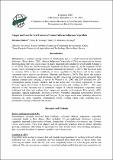Copper and Ascorbic Acid Content of Cooked African Indigenous Vegetables
Publication Date
2010Author
Florence Habwe, MK Walingo, MO Abukutsa-Onyango
Metadata
Show full item recordAbstract/
Malnutrition is common among women of childbearing age, it is made worse by micronutrient
deficiency (Farm Africa, 2006). African Indigenous Vegetables (AIVs) are important for dietary
diversification; they are a rich source of many micronutrients needed for good health (Oniang’o
et, al 2005). They are fast becoming the vegetable of choice especially in the segments of the
society where consumption has been minimal (Shiundu and Oniang’o, 2007). The increased need
to consume AIVs is due to availability of these vegetables to the lower end of the market
consumers whose majority are the poor (Shiundu and Oniang’o, 2007). This shows the urgency
of the need for information and knowledge on AIV processing and preparation alongside their
nutrient contents after cooking. A survey by Waudo et al., 2005 and 2007 revealed low AIV
consumption among women, children and in the urban and Peri-urban populations of Lake
Victoria region due to lack of knowledge on preparation and cooking of AIVs. The main
objective of this research was to formulate recipes of African indigenous vegetables using
traditional salt (lye) and evaluate their copper and ascorbic acid contents. Four priority AIVs
including: African nightshade (Solanum scabrum), Vegetable Amaranth (Amaranthus blitum),
Slenderleaf (Crotalaria ochroleuca) and Cowpea (Vigna unguiculata) were randomly selected to
formulate six more vegetable combinations before cooking where each vegetable had a
probability of being combined with another.

